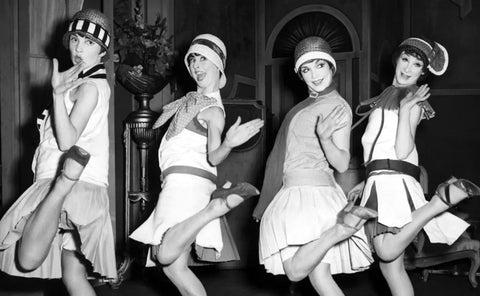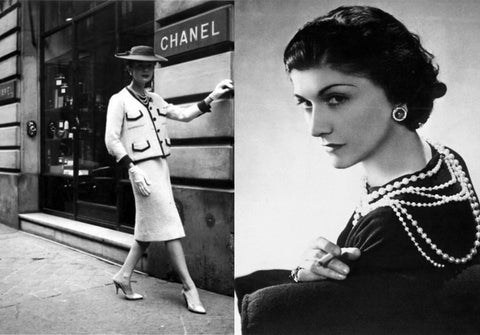
Coco Chanel, the flappers and their influence on current fashion.
La bizarre SusuShare

The flapper movement in the 1920s was not only a cultural and social change, but also left an indelible mark on the world of fashion. These rebellious women defied convention and set new trends that are still being felt in today's fashion.
One of the most distinctive features of flapper fashion was the break with the corset, a restrictive garment that symbolized female oppression. The flappers opted for looser and more comfortable garments that allowed them to move freely. Straight dresses with soft lines became the hallmark of her style. The flowing, straight fit of the dresses, often embellished with fringe, allowed women to dance and move without restriction, conveying a sense of freedom and empowerment.
Another key element of the flapper style was the haircut known as the "bob." Women dared to cut their hair above the shoulders, breaking with the traditional idea that long hair was a symbol of femininity. This bold and liberating cut became a fashion icon of the time, ushering in an era of change and authenticity in the way women expressed themselves through their appearance.
Flapper fashion was also noted for its inclination towards androgyny and the fusion of masculine elements in women's clothing. Coco Chanel, one of the most influential fashion figures of the time, challenged conventional norms by designing garments inspired by menswear. It introduced women's trousers, sailor-style jackets and tweed garments that broke with preconceived ideas of femininity and elegance. Chanel revolutionized fashion by offering women a more practical and functional alternative without sacrificing style and sophistication.
In addition, Coco Chanel was an advocate of wearing costume jewelery instead of expensive jewelry, which democratized fashion and showed that style was not limited by social class. His cutting-edge designs and revolutionary vision of fashion continue to influence the industry to this day. Chanel also popularized the use of elegant, neutral colors, such as black and white, which have become modern fashion staples.
Flapper fashion also incorporated vibrant colors, geometric prints, and statement accessories. Flappers dared to wear makeup more pronounced, with smoky eyes and dark lips, challenging conventional beauty standards. This bold and expressive approach to beauty influenced the makeup and hairstyling trends we see today, where creativity and individuality are valued.
Today, the influence of flapper fashion can be seen in many contemporary trends and styles. Flapper-inspired flowy shift dresses remain popular, especially for formal occasions and fashion events. Fringe, once a signature element of flapper dresses, has also made a comeback in a variety of guises, from garment embellishments to accessories and accents on bags and footwear.
Popularized by flappers, the bob haircut remains a bold and modern choice for many women. Whether it's a classic bob or a more contemporary variation, this haircut exudes a sense of confidence and edgy style.
Androgyny and the fusion of masculine elements in women's fashion are also current trends. Designers and brands have embraced the idea of combining clothing and styles traditionally considered masculine with feminine elements, thus creating a modern and liberating aesthetic.
Coco Chanel's legacy and her revolutionary approach continue to influence contemporary fashion. The idea of democratizing fashion and making it accessible to all women has permeated the industry, and renowned brands continue to embrace this philosophy. The combination of elegance, comfort and functionality in fashion is a direct reflection of the Chanel influence and the flapper movement.

In short, the fashion for flappers left a lasting mark on fashion history. Her boldness, liberation and redefinition of femininity have inspired generations of designers and shaped contemporary trends. From flowing dresses and fringe to bob haircuts and masculine fusions, flapper fashion continues to inspire those looking to express themselves and challenge established norms through their personal style.
The influence of Coco Chanel, one of the most outstanding figures of the time, has been fundamental in the evolution of fashion. His revolutionary vision and determination to break with established conventions have left an indelible mark on the industry. From her timeless designs to her focus on comfort and elegance, Chanel has influenced the way women dress and express themselves through fashion.
Today, the flapper aesthetic and the legacy of Coco Chanel continue to be celebrated and reinterpreted in contemporary fashion. The freedom from restrictions and the search for authenticity and individuality remain fundamental values in today's fashion. Designers continue to take inspiration from this revolutionary era and reinvent iconic flapper elements in a modern and relevant way.
Contemporary fashion reflects the influence of flappers and Coco Chanel through loose, comfortable clothing, bold haircuts, mixing masculine and feminine elements, and the use of elegant, neutral colors. Furthermore, the idea of democratizing fashion and making it accessible to all has been a lasting legacy of Coco Chanel.
Coco Chanel and her impact on contemporary fashion demonstrate how flappers and their revolutionary style have left an indelible mark on fashion history. Today's fashion has embraced and reinterpreted many of the key elements of flappers, such as loose, flowing dresses, fringe, the bob haircut, and the fusion of masculine and feminine elements. These elements reflect the search for comfort, individuality and personal expression that flappers promoted at the time.
Additionally, Coco Chanel's focus on democratizing fashion has changed the way women dress and relate to the industry. Chanel demonstrated that style is not limited by social class and popularized the use of elegant neutral colors that have become modern fashion staples.
